Introduction
Several companies in different parts of the world are listed in Stock exchanges to enhance their financial performances. One of the major objectives that make companies to be listed in the stock exchanges is to sell shares to the public to improve companies’ financial assets. However, major obligations for companies are also to create value for their shareholders, and to increase shareholders’ values, companies need to provide benefits for the money that shareholders invest in companies’ businesses. This is by declaring stock returns for the benefit of shareholders.
This report examines the stock performances of four Saudi Arabian companies. The report selects Saudi Arabian Basic Industries Corporation (SABIC), SAMBA financial group, SAVOLA, and Saudi Hotels and Resorts Company (SHARCO).
Saudi Arabian Basic Industries Corporation (SABIC)
Saudi Arabian Basic Industries Corporation (SABIC) is a multinational company specializing in producing a different kinds of products. Apart from producing petrochemical products, SABIC also manufactures a series of products ranging from steel, fertilizers, computers, medical equipments, and many building products. (SABIC annual report 2008). SABIC is the largest producer of petrochemical products in the Middle East and the 10th world’s largest producer of petrochemical materials. In addition, SABIC is the 10th largest producer of chemical products and ranks 500th position in fortune lists.
The availability of low-cost hydrocarbon resources in Saudi Arabia offers tremendous advantages to SABIC because the presence of low-cost hydrocarbon enhances SABIC’s competitive advantages and its financial position. Since more than a decade ago, the company’s capacity in the production of petrochemical products has increased four times, and by 2009, the company’s production of chemical products has reached 45 million tons. (Thomasson).
Established in 1976 under the royal decree 1976 to enhance optimum utilization of oil extraction, and apart from petrochemical products that SABIC manufactures, the company also manufactures Olefin, Aromatics, Chemical intermediary, and Oxygenates. (Global Investment House). SABIC became listed in the Saudi stock exchange in 1977, and 70% of SABIC’s shares are controlled by the Saudi government, and the remaining 30% are controlled by Gulf Co-operation Council.
There are many variables to access an industry historical, one of the key variables to access SABIC historical is its financial performance. This is a key variable to access company growth, and the extent it is creating values for its shareholders.
Key variables for industry historical (SABIC)
Many companies are operating under the petrochemical industry in Saudi Arabia, among them is SABIC. SABIC is a key player in the Saudi Petrochemical industry, and the principal activities of the Saudi petrochemical industry are to manufacture petrochemical products. The major segments under which SABIC operates are Petrochemicals, Metals, and Corporate. (Global Investment House, Corporate Information).
Thus, key variables for industry history are to access the financial and stock performances. SABIC’s financial performances reveal its profit and loss account, and its profit and loss show the extent SABIC has been accumulated growth since its establishment. Moreover, the stock data are also key variables to access the historical performances of a company. The stock data provides the extent to which a company has been able to create value for its customers.
Based on the past historical data, SABIC stock data in 2009 and 2010 will be relatively modest. For example, SABIC’s stock performances starting from January to April in 2009 are as follows:
TABLE 1: SABIC’s Stock prices and stock returns from January to April in 2009 (SR).
Data from financial records revealed SABIC financial results from January till March 2009 recorded a net loss of SR 0.974 billion because of the continued decline in prices of petrochemical products, and this impact led to the loss of earnings per share. It is revealed that SABIC recorded a loss per share of SR 0.33 in March 2009 compared to SR 0.33 where the company recorded earnings per share of SR 2.31 in March 2008. Based on the financial performances of SABIC, the following section provides a historical analysis of SABIC and the industry between 2006 and 2008.
SABIC historical analysis between 2006 and 2008
A SABIC’s main objective is to increase values for its shareholders and to be consistent in enhancing shareholders’ values. By achieving this, the company aims to improve the quality of productivity and maintenance of the high-quality standard. (Reed Business Information Limited.).
Analysis of SABIC’s financial statements reveals that the financial performances of SABIC tremendously improved between 2006 and 2008. For example, during these periods, the company recorded high performances in the overall sales. In 2006, SABIC recorded SR 86 billion in total sales, and in 2007, the sales’ value increased to SR 126 billion, and while in 2008, the total sales increased to SR 150 billion. However, the company’s net incomes between 2006 and 2008 were not encouraging. For example, in 2006, SABIC recorded SR 19.16 billion as net income, while in 2007, SABIC recorded SR 27 billion in net income. However, in 2008, the company’s net income was reduced, and the company recorded SR 22.09 billion as net income. (Saudi Basic Industries Corporation).
The company’s financial performances between 2006 and 2008 have an impact on overall shareholders’ equity. For example in 2006, SABIC recorded SR 25 billion as share capital. Although, in 2007, there was no improvement in the total company share capitals because SABIC recorded the same SR 25 billion. However, in 2008, SABIC recorded improvement because the company declared SR 30 billion as share capital.
In addition, in 2006, the company’s total equity was SR 73 billion, and in 2007, the total shareholder’s equity increased to SR 91 billion. In 2008, total shareholders’ equity also increased to SR 103 billion. Meanwhile, the total equity improved between 2006 and 2008. In 2007, the total equity was SE 100 billion while in 2007 the total equity increased to SR 135 billion, and in 2008, the total equity for SABIC also improved by increasing to SR 147 billion. The improvement of company share capital had positive impacts on the company’s returns for its shareholders. For example, between 2006 and 2008, there were improvements in the dividends declared by SABIC for its shareholders. For example, in 2006, SABIC declared SR 8.12 earnings per share. In 2007, earnings per share increased to SR 13.99. However, in 2008, the company earnings per share declined because SABIC declared SR 12.57 earnings per share for its shareholders. (See fig 1).
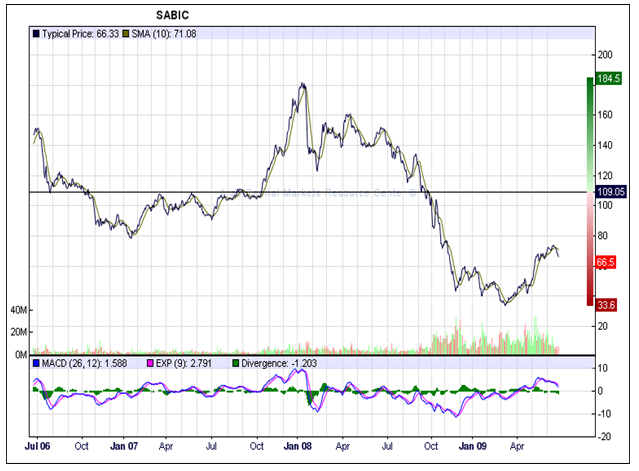
The negative returns that SABIC declared for its shareholders were because of the negative net income the company declared in 2008. Net incomes in 2006 declared were SR 20 billion, and the total net income declared in 2007 was SR 27 billion. However, in 2008, the SABIC recorded a negative net income of SR 22 billion, and this had overall effects on the earnings per share 2008. Although, the negative net income recorded in 2008 did not have an impact on dividends the company paid to its shareholders in 2008. For example, dividends declared by the company in 2006 were SR 6.25 billion, and in 2007 the dividends paid were SR 8.79 billion, and in 2008, the total dividends paid were SR 10.28 billion.
With the negative net income that SABIC declared between 2007 and 2008 and negative earnings per share between 2007 and 2008, the reasons have been attributed to the risks that SABIC was facing during the period.
Analysis of industry and company risks
The decrease in company net incomes and negative earning per share could be attributed to some certain industrial risks that the company faced. For example, there was a decline in the prices of petrochemical products and metals, which led to a decline in net income during the periods. In addition, the recent credit crunch that has affected many industrial economies also attributed to difficulties, which customers of petrochemical products faced in accessing credit facilities from banks, and financial institutions. The impacts led to a decline in demand for petrochemical and metal products.
For instance, Mohamed Al-Mady, CEO, and vice-chairman of SABIC declared, “the financial and economic crisis that hit the world’s major economies and the credit crunch have led to difficulties for customers accessing credit facilities from banks and financial institutions. This has contributed to the decline in demand for petrochemical products and metals, in particular engineering plastics, which have been impacted by the recession in the automotive, construction, and electronic industries. These developments accelerated the pace of decline in the prices of petrochemical products and metals, adversely impacting the performance of global companies, including SABIC”. (AME Info).
With problems that SABIC are facing over the years, this report provides a recommendation on the investment portfolio for 2009 and 2010.
Recommendation for investment portfolio between 2009 and 2010
With references to historical data, investment portfolio in industry and SABIC between 2009 and 2010 is not encouraging. The reason is attributed to the net loss of SR 0.974 billion that SABIC recorded in the first quarter of 2009. As being pointed out by Mohamed Al-Mady, “the continued decline in prices for most petrochemical products and metals led to a decline in the profitability during the first quarter of 2009 compared to the same period last year. The income from operations for the quarter ended March 31, 2009, was SR0.380bn compared to SR10.891bn in the same period of 2008. The loss per share for the quarter ended March 31, 2009, was SR0.33 compared to earnings per share of SR2.31 for the same period in 2008”. (AME Info).
From the statement of SABIC’s vice chairman, the investment portfolio between 2009 and 2010 is not encouraging because of the recent loss that SABIC has recorded. In addition, the recent economic crisis has negatively affected the petrochemical industry, and many petrochemical companies have gone bankrupt, and this led to the closure of a large number of plants, and staff demobilization. (AME Info).
SAMBA financial group
Samba financial group was formed from the Royal Decree in 1980. With its formation, SAMBA took over the existing branches of Citi bank in Saudi Arabia, and with accordance of 1970 program in Saudi Arabia, all companies listed in Saudi stock exchange must sell the majority of companies’ equity interest to Saudi nationals, and in 1980 SAMBA started business operations in 1980. (SAMBA). Samba financial group formerly known as Saudi American Bank is the second-largest bank in Saudi Arabia with total assets of USD28.9 billion in 2005. The merging of Samba with the United Saudi Bank made Samba Financial Group become the second largest bank in Saudi Arabia.
SAMBA offers a range of banking products such as loans, financial advisory, services, underwriting, and transaction. (Zawya BD).
Analysis of financial institutions in Saudi reveals that Saudi Arabia’s banking sector is profitable in the last few decades, with returns on assets. Typically, the financial institution is characterized by stability due to an effective regulatory and supervisory structure. (International Monetary Fund). However, due to the current financial crunch that is affecting most advanced countries, the effect of the credit crunch is also affecting financial institutions in Saudi Arabia. Investment report from business week reveals that most financial institutions perform better in 2008 than in the first quarter of 2009 (See fig 2). For a better understanding of SAMBA financial analysis, it is essential to discuss the historical analysis of SAMBA financial group.
Key variables for historical analysis of SAMBA financial group
Under Saudi financial institutions, the industry consists of commercial banks, insurance, mutual fund, and mortgage banks. The Saudi financial institution plays a critical role in granting the loan, underwriting, foreign exchange transactions, and other financial transactions.
Typically, SAMBA financial group is the second-largest bank in Saudi Arabia, and the key variable to measure SAMBA historical is to analyze company financial performances in the last three years.
The historical analysis will also involve analysis of stock data to examine the extent SAMBA shares of SAMBA have performed in the last three years. The historical data will enhance the report on the investment portfolio between 2009 and 2010. To examine the performances of SAMBA financial group, the next section examines historical financial report between 2006 and 2008
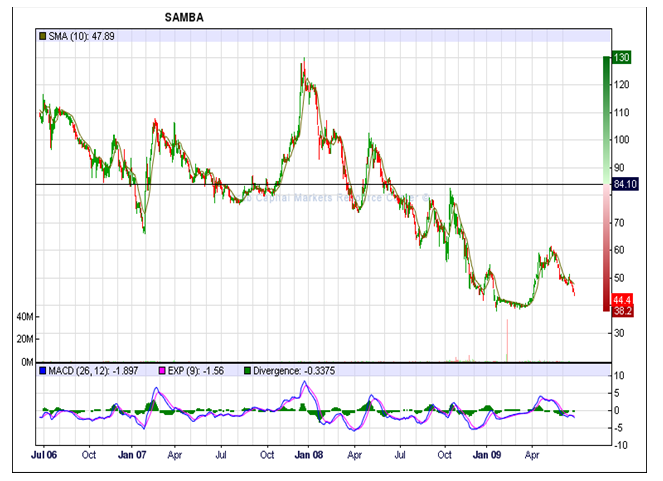
SAMBA historical analysis between 2006 and 2008
Although, one of the major objectives of the SAMBA financial group is to enhance shareholders’ values as well as increase company growth. However, historical data reveal that SAMBA’s shares performances have underperformed between 2006 and 2008. (See fig 2 for a detailed chart from 2006 till 2009). For example, the company’s net income in 2006 was SR 5.2 billion. However, in 2007, the net income of Samba financial group declined, and the company recorded approximately SR 4.8 billion. In 2008, the company did not improve its earnings, and SAMBA recorded approximately SR 4.5 billion.
The decline in net income between 2006 and 2008 had an impact on dividends that the company declared for its shareholders between 2006 and 2008. For example, in 2006 the ordinary dividends declared were SR 1.1 billion. However, in 2007, the SAMBA declared SR 0.6 billion as dividends. Although the company recorded little improvement in 2008, because the ordinary dividends declared was SR 0.7 billion. It is essential to realize the improvement in 2008 did not indicate good performance for the company because SAMBA did not 2006 target.
Performances of shares between 2006 and 2008 had an impact on the SAMBA’s share prices in 2006 and 2008. For example in the company share prices on December 20 2006 was SR 88.5, and in 2007, the share prices had increased to SR 127. However, in December 2008, the SAMBA share prices were reduced to SR 46.
The decline in share prices can be because of several factors. The recent global credit crunch affecting major industrialized countries emanated from financial institutions. Many banks and some other financial institutions in Europe, and United States are being affected by the recent credit crunch, and this led to the closure of some banks and financial institutions in Europe and the United States. Meanwhile, the impact of the credit crunch has also swept to the Middle East including Saudi Arabia. Thus, SAMBA is facing a lot of risks in its operations.
The next section examines risks facing the financial institution and the company in Saudi Arabia.
Analysis of industry and company risks
There are many challenges that SAMBA financial group is facing in recent years. Typically, since 2006, there has been full of challenges for local, regional and international financial institutions. (Samba Financial Group).
SAMBA is facing market risks, and there is a general fluctuation in the overall general performance. In addition, the group is also facing risks such as fluctuation in exchange rates, cash flow fluctuation, and equity prices fluctuations.
Typically, the fluctuations in market variables have several impacts on the share performances over the years. For example, since 2006, the shares performances had declined, and the decline in shares’ performances has continued till April 2009 (See fig 2).
Apart from market risks, SAMBA financial group is also facing competition from other financial institutions in Saudi Arabia. Other financial institutions such as Arab National Bank, Abu Dhabi Commercial Bank, Emirate Islamic Bank, National Bank of Bahrain, The Gulf bank, and other financial institutions in Saudi Arabia. With market risks facing SAMBA financial group, the next section provides recommendations for investment portfolios between 2009 and 2010.
Recommendation for investment portfolio between 2009 and 2010
SAMBA financial group has continued to underperform since 2006. In 2009, the stock performances show that there has been a gradual decline in SAMBA share performances. For example, a recent report reveals that there has been a gradual decline in the profit of the SAMBA financial group toward the second quarter of 2009. Thus, it is advisable for prospective investors not to invest in the periods of 2009 and 2010. (See chart of 2009 stock performances in fig 2).
SAVOLA
SAVOLA is among the Agricultural & Food Industries in Saudi Arabia, and leading industrial companies, and ranked 13 positions among the top listed companies in Saudi Arabia. Established in 1979, SAVOLA started with an initial capital of SR 40 Million, however, its capital base increased to SR 5 Billion over the years. An increase in company assets makes SANOVA become one of the most successful and fastest multinationals in the Middle East, North Africa, and Central Asian countries. Typically, SAVOLA deals in edible oils, sugar, noodles, and pasta. Apart from these products, SAVOLA also deals in packaging, real estate, and franchising. SANOVA operates business in four sectors: SAVOLA foods, SAVOLA retail sector, Real estate sector, and SAVOLA plastics. Presently, SAVOLA group employs up to 16, 000 employees and has approximately 160, 000 shareholders. (SAVOLA).
Due to the attractiveness of SAVOLA stocks, the group has over 160,000 shareholders, with a market capitalization that reached SR 12 billion in December 2008.
In addition, the company’s total capital reached SR 5 billion in 2008 and revenue in 2008 reached SR 13.8 billion, while the company net profits reached SR 202 million. (SAVOLA).
For a future forecast of 2009 and 2010, it is essential to examine the key variables for historical analysis of SAVOLA.
Key variables for historical analysis of SAVOLA
Key variables in analyzing SAVOLA’s historical are its overall financial summary. Typically, being one of the largest industrial groups in edible food, retail, real estate, and plastic sectors. The company has enjoyed high financial performance since its inception in 1979. Typically, the company stock data generally perform well and reach its peak in 2008 (See fig 3 for detail chart). The equity ratio revealed that from 2006, there has been a decline in the company’s return since 2008. Thus, the next section analyses SAVOLA historical between 2006, and 2008.
SAVOLA historical analysis between 2006 and 2008
Between 2006 and 2008, it is revealed that the company declared net revenue of SR 9.09 billion in 2006 and 2007, the company declared SR 10.4 billion in 2007, and in 2008, there was an increase in net income, which was SR 13.8 billion. The increase in net income between 2006 and 2008 made dividends SAVOLA declared for its shareholders to increase between 2006 and 2008. For example, in 2006, the dividends declared were SR 181.6 million and in 2007, the dividends declared to its shareholders increased, and the company declared SR 243.78 million. In 2008, SAVOLA declared SR 376 million as dividends for its shareholders.
However, between 2006 and 2008, the shareholder’s equity of the company was modest. In 2006, the total shareholder’s equity was SR 6.04 billion, and in 2007, the shareholders’ equity increased, and the company recorded SR 7.15 billion, however in 2008, there was a reduction in the total equity compared to 2007, and the company recorded total equity of SR 6.38 billion.
Although, company revenue increase between 2006 and 2008, however, group net profits were not encouraging between 2006 and 2008. For example, in 2006, the net profit declared by the company was SR 1.2 billion, and in 2007, the net profits increased, and the company declared SR 1.23 billion. However, in 2008, there was a great reduction in the company’s net profits and the group declared only SR 202 million. (SAVOLA Annual report 2008).
The reason for the overall decline in the net profits of the SAVOLA group can be attributed to the global financial crisis that led to the sharp collapse of major commodity prices. Evidence is revealed from the statement of the chairman of SAVOLA group who declared, “this was a sharp decline in profitability from the SR 1.23 billion achieved in 2007. Profitability suffered from two main contributing factors: first, the sharp collapse of the world commodity prices, followed by the second, the decline of equity markets. Both resulted from the financial crises that arose during the second half of 2008. The collapse in commodity prices completely offset the first nine months of profits by the Foods sector—SR 253 million generated in the first three quarters”. (SAVOLA Annual report 2008).
The chairman statement makes this report to analyze industry and company risks.
Analysis of risks facing SAVOLA group
There are many risks that the group is currently facing. It should be noted that the group is operating in different countries, and thus the company is facing a risk of fluctuation in foreign exchange. Apart from this, the group is also facing market risks in the commodity markets that led to a decline in global prices of the company products. The Chairman remarked on the risks facing the group when he stated “The sharp decline in profitability was a result of two main contributing factors: first, the sharp collapse of the world commodity prices, followed by the second, the decline of equity markets. Both resulted from the financial crises that arose during the second half of 2008. The collapse in commodity prices completely offset the first nine months of profits”. (SAVOLA Annual report 2008).
Apart from the collapse in commodity prices, the company is also facing major competition. Major competitors of SAVOLA group are Jarir Marketing Co, Seef Properties Co, National Agric Marketing Co, and other companies in the same industrial sector.
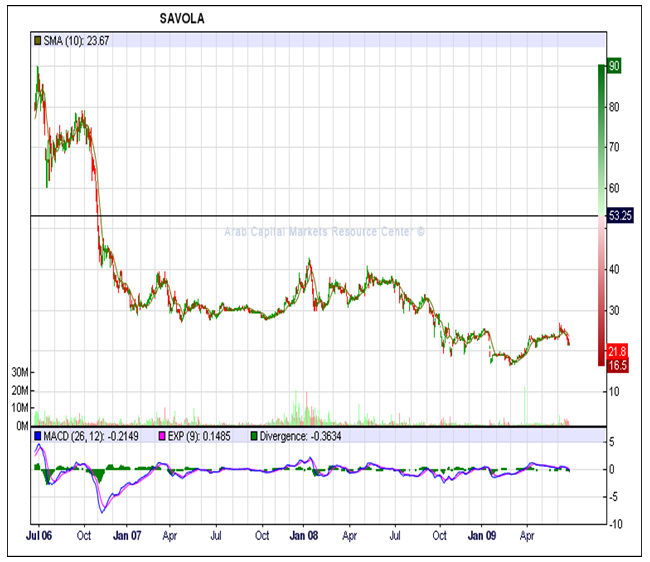
Recommendation for investment portfolio between 2009 and 2010
Recommendation for investment portfolio for the group can base on the historical investment portfolio. Investment portfolio between 2009 and 2010 is not advisable. Based on the historical data, the share performances of SAVOLA are not encouraging. Fig 3 points to a sharp decline in the shares’ performances of the group from 2006 till 2009. Moreover, there has been a decline in the returns of equity between 2007 and 2008. The Financial analysis SAVOLA reveals that an investment portfolio between 2009 and 2010 is not advisable.
Saudi Hotels & Resort Areas Co (SHARCO)
Saudi Hotels and Resorts Company (SHARCO) is among the Saudi shareholding companies. Established in 1979, SHARCO primarily engages in four main segments. The company engages in real estate, hospitality, resort, and entertainment. Although, a large part of its business is the hotel, and the company’s portfolio hotels include Sahara Airport, Riyadh Marriott, Al-Andalus Villas, and Ajyad Makkah Hotel. In addition, SHARCO’s stake in the following hotels is as follows:
- 52.38% stakes in Tabouk Hotels Co. Ltd.
- 51.11% in Makkah Hotels Co. Ltd.
- 50.63% in Annakheel Resorts Co. Ltd.
- 50.48% in Al-Khaleej Resorts Co. Ltd.
- 50% Madinah Hotels Co. and
- 50.41% Riyadh Hotels & Entertainment Co. Ltd.
Moreover, SHARCO’s entertainment sector is called Al Rawda Entertainment Garden and is the Saudi largest park for children and women with 47 rides and games for entertainment. The real estate that the company is controlling consists of Commercial Tower and Future Homes, Al Jazeerah East Compound, Al-Dawoudia Complex, Al Jazeerah Residential, and Al Jazeerah Bader Villas. (financial, Google Finance, Business week, Arabian Business).
Future forecast for 2009 and 2010 requires examining the key variables for SHARCO’s historical analysis.
Key variables for historical analysis of SHARCO
To examine the key variables of SHARCO, it is essential to examine the company’s financial summary.
SHARCO is a leading company in the hotel and tourism sector in Saudi Arabia, and since its inception, the company has enjoyed rapid growth, and its financial performances have increased rapidly. Rapid performances in the company stocks led to an increase in the number of shareholders. However, in 2006, SHARCO’s recorded the highest performances in stocks because this was the year that the performances of the company shares’ reached their peak.. Although, after 2006, there has been a gradual decline in the shares’ performances. However, since 2007, the stock performances have been relatively stable. Although, there was a slight decline in stocks performances in 2008. However, in 2009, stocks have started showing little improvement since April.
Next section analyses the financial history of SHARCO between 2006 and 2008.
SHARCO historical analysis between 2006 and 2008
The historical analysis of Saudi Hotels and Resorts Company (SHARCO) reveals that the company’s net income has improved between 2007 and 2008. In 2007, the company’s net income was SR 77.7 million, and in 2008, SHARCO showed improvement in net income by recording SR 123 million. Returns on equity also improved between 2007 and 2008. In 2007, the indication of key ratio revealed that in 2007 SHARCO recorded 9.76% in the equity return, and in 2008, SHARCO recorded 11.34% on the return of equity. In addition, the net sales between 2007 and 2008 were also encouraging. In 2007, SHARCO recorded SR 264 million in net sales and by the end of 2008, the net sales had increased to SR 294 million.
Despite the company’s financial improvement, SHARCO is also facing some risks. Next section analyses risks that SHARCO is facing.
Analysis of risks facing SHARCO
There are risks that Saudi Hotels and Resorts Company (SHARCO) is facing. Presently, SHARCO is facing competition from several other companies that offer the same services that SHARCO is offering. Among the companies that SHARCO is competing for the market, shares are Al Anwar Holding Co, Al Safat Investment Co, Al Madina For Financer and Investment, Commercial facilities Co, and Gulf General Investment, and other companies that offer the same services. Typically, all these companies are listed on the Saudi stock exchange, and all of them are aggressively seeking a major cut in market shares in Saudi Arabia.
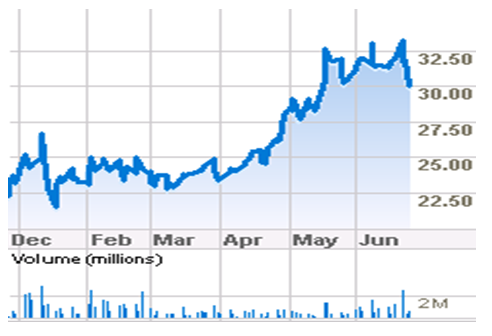
Recommendation for investment portfolio between 2009 and 2010
From the company financial record, it is revealed that the investment portfolio for SHARCO between 2009 and 2010 is likely to be favorable. This is revealed from a chart in Fig 4, which summarizes the investment portfolio of SHARCO for 2009, and Fig 5 that reveals stock performances from 2004 till June 2009. From the charts, it is revealed that the investment portfolio for the company will be favorable between 2009 and 2010. It should be noted that since April 2009, SHARCO shares performances are climbing. (See fig 4). Thus, investment portfolio in 2009 and 2009 is encouraging in this company.
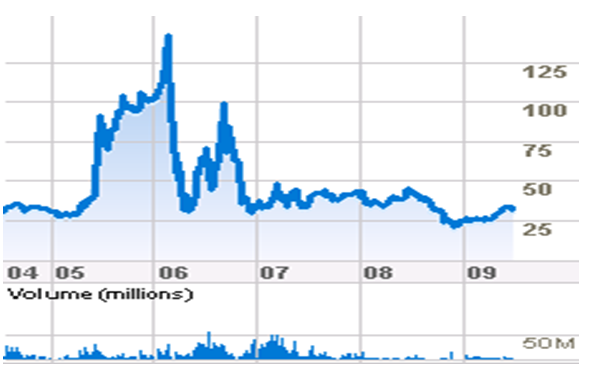
Conclusion
The report provides an analysis of stock performances of four companies listed in the Saudi Arabia stock exchange. The companies examined in this report are Saudi Arabian Basic Industries Corporation (SABIC), SAMBA financial group, SAVOLA, and Saudi Hotels and Resorts Company (SHARCO). Analysis of these companies reveals that all of them performed favorably in 2006, where the shares’ performances were at the peak in 2006. However, from 2006, the stock returns of these companies have not improved 2006 and 2008. However, it was only SHARCO that recorded stock’s improvement from April 2009 to June 2009.
Data in appendix 1 reveals portfolio management for SABIC, SAMBA, SAVOLA, and SHARCO, which reveal the overall stock prices and stock returns between 2007 and 2009. It is only the stocks returns of SHARCO that show improvement in 2009. Thus, this report recommends that an investment portfolio for SHARCO is advisable in 2009 and 2010. However, investment portfolios are not advisable in the case of SABIC, SAMBA, and SAVOLA because of their low performances in stock returns.
Work cited
AME Info, Sabic reports preliminary consolidated financial results for Q1, Press Release, 2009.
Arabian Business, Saudi Hotels and Resort Areas Company, Arabian Business, 2009.
btflive.net, Hotel & Tourism Sector » Tourism Enterprises Co. (TECO). Web.
Business week, Saudi Hotels & Resort Areas Co (4010: Stock Exchange), Business Week Magazine, 2009.
Corporate Information, Saudi Basic Industries, Wright Investors’ Service, 2009.
Global Investment House, Saudi Basic Industries Corporation (SABIC) – Initial Equity Research, Equity Report, 2008.
Global Investment House, Petrochemical Industry Saudi Arabia Economic and Strategic Outlook, Economic Report, 2008.
Google Finance, Saudi Hotels & Resort Areas Company (Public, SAU:4010). Web.
International Monetary Fund, Financial System Stability Assessment, Monetary and Financial Systems and Middle East and Central Asia Departments, 2004.
infinancials, Database of infinancials.
Portfolio management from excel.
Reed Business Information Limited, Sabic Strategy and Financial Highlights Information from ICIS, 2009.
Samba Financial Group, 2007 DIRECTORS’ REPORT.
SAMBA financial group, About Samba. Web.
Saudi Basic Industries Corporation, Financial performance. Web.
.SAVOLA, About About the Savola Group. Web.
Thomasson, Anne, CMAI Outlines SABIC’s Strategic Business Position, Chemical Market Associate Inc, 2007.
Zawya BD, Samba Financial Group (1090.SSE), Company update, 2008.
Appendices
Appendix 1: Stock prices and stock returns of SABIC, SAMBA, SAVOLA, and SHARCO between 2007 and 2009.